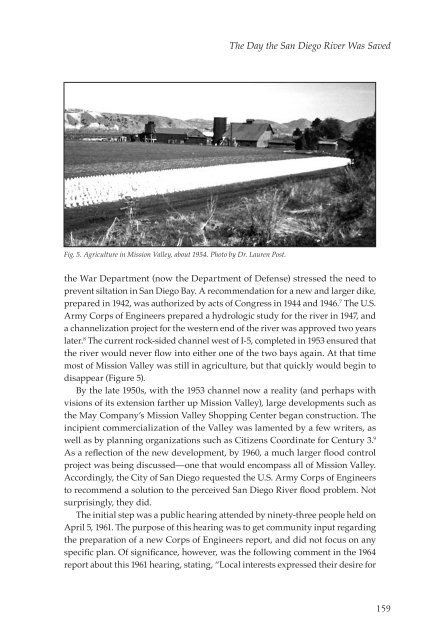Summer 2011, Volume 57, Number 3 - San Diego History Center
Summer 2011, Volume 57, Number 3 - San Diego History Center
Summer 2011, Volume 57, Number 3 - San Diego History Center
Create successful ePaper yourself
Turn your PDF publications into a flip-book with our unique Google optimized e-Paper software.
The Day the <strong>San</strong> <strong>Diego</strong> River Was Saved<br />
Fig. 5. Agriculture in Mission Valley, about 1954. Photo by Dr. Lauren Post.<br />
the War Department (now the Department of Defense) stressed the need to<br />
prevent siltation in <strong>San</strong> <strong>Diego</strong> Bay. A recommendation for a new and larger dike,<br />
prepared in 1942, was authorized by acts of Congress in 1944 and 1946. 7 The U.S.<br />
Army Corps of Engineers prepared a hydrologic study for the river in 1947, and<br />
a channelization project for the western end of the river was approved two years<br />
later. 8 The current rock-sided channel west of I-5, completed in 1953 ensured that<br />
the river would never flow into either one of the two bays again. At that time<br />
most of Mission Valley was still in agriculture, but that quickly would begin to<br />
disappear (Figure 5).<br />
By the late 1950s, with the 1953 channel now a reality (and perhaps with<br />
visions of its extension farther up Mission Valley), large developments such as<br />
the May Company’s Mission Valley Shopping <strong>Center</strong> began construction. The<br />
incipient commercialization of the Valley was lamented by a few writers, as<br />
well as by planning organizations such as Citizens Coordinate for Century 3. 9<br />
As a reflection of the new development, by 1960, a much larger flood control<br />
project was being discussed—one that would encompass all of Mission Valley.<br />
Accordingly, the City of <strong>San</strong> <strong>Diego</strong> requested the U.S. Army Corps of Engineers<br />
to recommend a solution to the perceived <strong>San</strong> <strong>Diego</strong> River flood problem. Not<br />
surprisingly, they did.<br />
The initial step was a public hearing attended by ninety-three people held on<br />
April 5, 1961. The purpose of this hearing was to get community input regarding<br />
the preparation of a new Corps of Engineers report, and did not focus on any<br />
specific plan. Of significance, however, was the following comment in the 1964<br />
report about this 1961 hearing, stating, “Local interests expressed their desire for<br />
159







![[PDF] The Journal of San Diego History Vol 52: Nos 1 & 2](https://img.yumpu.com/25984149/1/172x260/pdf-the-journal-of-san-diego-history-vol-52-nos-1-2.jpg?quality=85)

![[PDF] The Journal of San Diego History - San Diego History Center](https://img.yumpu.com/25984131/1/172x260/pdf-the-journal-of-san-diego-history-san-diego-history-center.jpg?quality=85)







